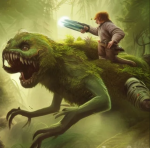The same is being said about AI art. The counter-argument is that at this rate of progression, it won't be too long until it does (fill in the blank with something you say it doesn't do well).
Just like "the singularity", I'll believe it when I see it. The people pitching that particular line of hype have a radically different conception of what a mind is--I might even say I can
directly observe that their take on "the singularity" is incorrect. I can observe that my mind is not made out of atoms and electrons, even though my brain[1] and sensory systems feeding into the mind are. Those people would not agree with that statement of course; they'd hypothesize that my mind is an emergent property of the right atoms interacting in the right ways (and maybe they would mumble something about "quantum effects"). But I don't have to persuade them that they're wrong; reality itself will do that.
(There's more to say about the bad assumptions feeding into the narrative of singularity, even if minds
were made purely out of atoms
, but I'll forebear.)
This is not to say that I doubt that AI art can get much, much better than it currently is, but it's still essentially an infinite number of monkeys at an infinite number of keyboards, plus some nifty algorithms to filter out the most egregiously nonsensical of the monkey outputs. From a technical standpoint I'm really impressed with chatGPT. From a gaming standpoint... I'm not optimisic about the GPT route producing usable (trustworthy!) gaming material largely because GPT is
too powerful, i.e. not restricted enough. A good
hexflower or
ladder table could generate an interesting random map populated with interesting things to do, and I could have confidence that it will not do insane things like make three friendly NPCs (Loyalists) spontaneously morph into one hostile (Nemesis) and one friendly (Loyalist) with no explanation for what happened to the third one. I know that it can't do that because the ladder table has no entry for "NPC vanishes into thin air," but GPT is powerful enough that it can do things like that.
AI art is really promising as a way to essentially commission cheap custom art for those of us who can't draw and aren't going to use the art for anything worth paying a human $1000 for. It will be good for gaming in the sense that I'll be able to say "skull-faced hobbit with a laser gun riding a building-sized tarantula through a forest, with shrieking orcs running in all directions" and have a good chance of getting at least one result that isn't terrible. But that's mostly because it's pretty fast and low-effort to evaluate a painting as good enough/not good enough, unlike adventure module text.
skull-faced hobbit with a laser gun riding a building-sized tarantula through a forest, with shrieking orcs running in all directions:

Not great, but either I try again (or give up) or I decide that I like it enough to modify my adventure accordingly: instead of a tarantula, it's a treant-bug, and instead of a skull face the hobbit has a prosthetic hand with steel claws.
[1] I can observe that e.g. dredging up old memories and recognizing faces are both activities conducted largely or entirely by physical systems built out of neurons, obviously in the brain. I'm not denying that atoms are useful! But so is scratch paper, and my mind is not made out of scratch paper.
